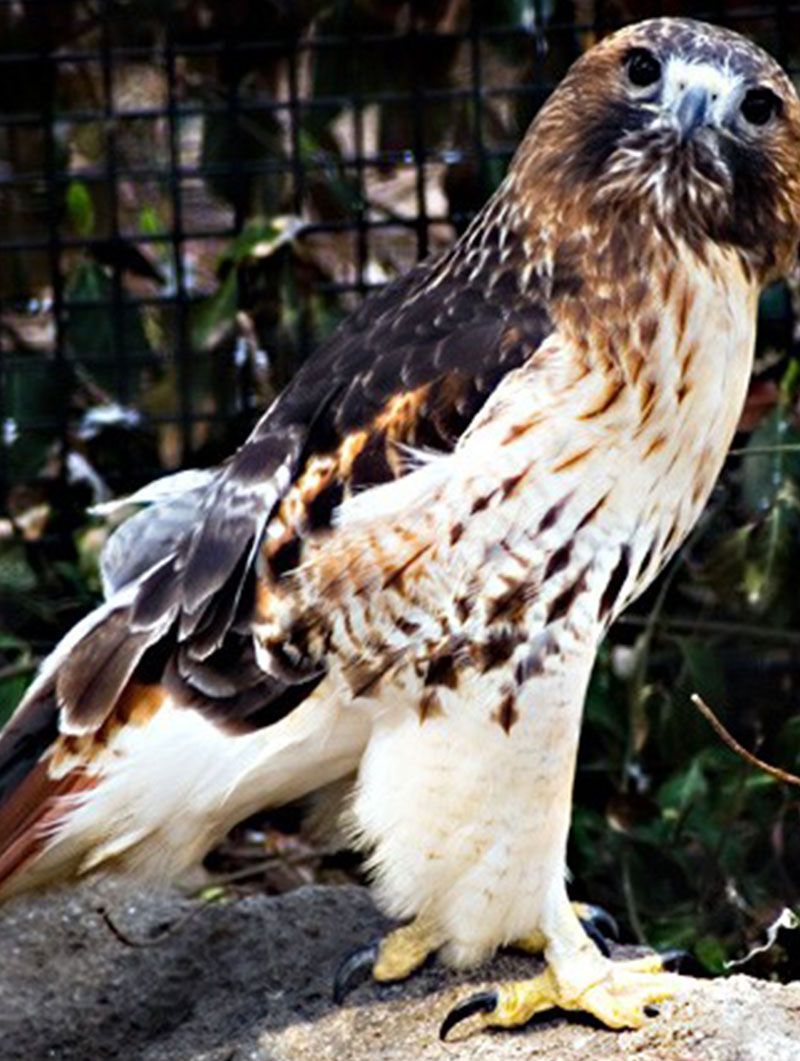Red-tailed Hawk
Buteo jamaicensis
Description:
A red-tailed hawk has a brown or grayish-brown back with pale markings. Its chest is white with a darker “belly band”. The short, broad tail feathers are uniformly red, and the legs and feet are yellow.
Size:
A red-tailed hawk measures between 18 and 25 inches (45.8-63.5 cm) in length, with a wingspan of 3.5-4.5 feet (1.1-1.4 m). It weighs about 2.5 pounds (1.1 kg). As with most birds of prey, the female is nearly 1/3 larger than the male.
Adaptations:
As a predator, the red-tailed hawk has many adaptations which help it to catch its prey.
- This hawk has keen eyesight, which is eight times more powerful than the eyesight of a human.
- There is a bony ridge over the eye socket that provides shade for the eyes in direct sunlight, similar to the way a baseball cap provides shade for our eyes.
- A red-tailed hawk’s curved beak and sharp talons help it to efficiently catch its prey.
Diet:
Red-tailed hawks are carnivores (meat-eaters) that eat mainly rodents, but also rabbits, reptiles, and other birds. At Cosley Zoo, the hawk is fed mice, rats and quail.
Reproduction:
Red-tailed hawks typically form lifelong pair bonds. The large nest is located high in a tree, and is built out of sticks, bark, and leaves. The same birds may use one nest for several years. The female lays 1-5 eggs in each clutch. Eggs are white speckled with brown. Both parents taking turns sitting on the eggs during the 30-day incubation period. In late spring, after the eggs have hatched, the female cares for the young while the male provides them all with food. After 42 to 46 days, the chicks begin to fly. When they are 10 weeks old, they go out on their own.
Shelter and space needs:
Red-tailed hawks live in areas that are mostly open but contain some trees. They use the open areas for hunting and the trees for nesting.
Life expectancy:
Red-tailed hawks have a high mortality rate for the first two years of their lives. If they survive this period, their life expectancy is 10 to 15 years. Their life expectancy in human care is slightly higher.
Relationship with man:
Red-tailed hawks help to control the populations of small prey animals, such as mice and rabbits. They also provide homes for other birds that use their nests.
Fun Facts:
-
- The red-tailed hawk is the most common and widespread hawk in North America.
- Red-tailed hawks perch on tree limbs, telephone poles, or other high structures to look for prey. When they see a prey animal, they drop down on it from above.
- This type of hawk is sometimes known as the “chicken hawk”, even though these birds rarely kill chickens.
- Although the eggs and young birds are vulnerable, adult Red-tailed hawks have very few predators
.







